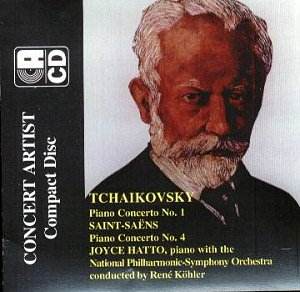The critic’s hard heart can sink at yet another Tchaikovsky
in B flat minor. What can one say? From supercharged Horowitzian
glitter to the languorous narcissism of Pogorelich the catalogue
groans under the weight of entrants ranging from Tchaikovsky favourite
Sapellnikoff in 1926 to the latest octave-busting wunderkind.
If your tastes embrace, in addition to the above, say, Gilels,
Richter, Solomon, Rubinstein (with Barbirolli) or Argerich you
will be more than content and the prospect of another visitant
will not necessarily be overwhelmingly exciting – but then that
depends very much on the quality of the performance. And this
latest Concert Artist release is by a known and long admired exponent
of the literature, the ever remarkable, challenging and eloquent
Joyce Hatto. Her long series of recordings for this company has
once again launched her world-class technique and imagination
onto an ever-wider stage.
This is indeed a most perceptive and revealing
performance, one that fuses muscular control with acumen and insight
and in so doing opens up unexpected vistas in a work all too often
taken for granted. She has leonine strength – no doubt about it
– and a technique to match. With the strength comes clarity –
of passagework, yes, but also of intellectual and architectural
vision. Her rhythmic strength is undoubted as well. Listen to
her deliberate retardation of the solo line in the first movement
as she generates tension through the minutest of such gradations.
And here there are also moments where she perfectly integrates
the bravura with moments of intense, almost speculative reflection.
She explores an improvisatory quality in the first movement that
one does not ordinarily hear. At 11.40 the romantic tracery takes
on, in her hands, a bewitching aspect – one almost pointillist,
almost proto-impressionistic in its compression. At such moments
she seemingly takes the concerto beyond itself. In timing she
is equidistant between Richter and Pogorelich – but she generates
and sustains her own time here, unhindered by external temporal
considerations. Her Andantino is notable for a splendid sense
of her ensemble generosity. How verdant is the flautist here,
the orchestral playing being fiery and sometimes raw but extremely
exciting in general under René Köhler’s strong but
fluid direction. Hatto brings an aristocratic humour to her pointing
and in the Prestissimo section she is splendidly buoyant, avoiding
all sense of indiscriminate and generalized powerhouse playing.
Some may find her slow but many others will appreciate her finesse
and sensitivity. In the finale she once more generates tension
through shaping and not imposing it externally via less musical
means. So once more she is, for example, as in the slow movement,
half a minute slower than Solomon/Harty. There is a wealth of
detail here to savour from the moulding and inflections, the powerful
orchestral accelerandi, the finely chirping woodwind and the galvanizing
triumph of the final bars, which end a performance of constant
illumination and imaginative control.
Coupled with the Tchaikovsky is Saint-Saëns’
No. 4. She plays the Chaconne-like opening introduction with pensive
and withdrawn tone, chordally terraced with acumen, tonally splendid.
She doesn’t attempt to replicate Cortot’s more extreme rubati
(with Münch, 1935) though she doubtless discussed this concerto
with him in their work together after the War. Her right hand
runs are laced, quick, superfine, but unostentatious and no bar
to bringing out the melodic impress they bear. She and Köhler
are nowhere near as suave as, say, Entremont with the Philadelphia
and Ormandy but then I don’t think suavity is called for here.
By comparison with Hatto Entremont is hard, unyielding and just
plain lumpy. The wind and piano exchanges have a really delicious
affection to them and Hatto displays once more a characteristic
of hers in concertante works, which is to bind bravura and intimacy
so tightly that they become identifiable components of each other.
Hatto can be declamatory and bold but her tone never curdles or
hardens (it’s a characteristic of his, possibly exaggerated by
the CBS recording, that Entremont’s tone very definitely does
harden, and not just at climaxes). Her rolled chords are wonderfully
eloquent, her diminuendi full of poetry and her inwardness carries
with it mystery and depth. In the Allegro vivace she is delightfully
sprung and aerated - and serenity courses through the Andante
of the tripartite second movement before a driving concluding
Allegro. This, buoyed up by real tuneful elation, ends the work,
and the performance, in triumph.
This is a persuasively impressive coupling. Those
jaded by the Tchaikovsky may well want to sample Hatto’s Saint-Saëns
– but will, I’m sure, stay to admire her performance of the former,
which is as intelligent, sensitive and unselfconsciously authoritative
as the latter. Individual and strong, Hatto’s performances never
fail to inspire.
Jonathan Woolf
MusicWeb
can offer the complete
Concert Artist catalogue

![]() Joyce Hatto (piano)
Joyce Hatto (piano) ![]() CONCERT ARTIST/FIDELIO
RECORDINGS CACD 9086-2 [61.47]
CONCERT ARTIST/FIDELIO
RECORDINGS CACD 9086-2 [61.47]